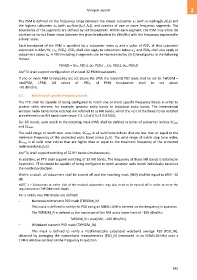Page 655 - 5G Basics - Core Network Aspects
P. 655
Transport aspects 2
The PSM is defined on the frequency range between the lowest subcarrier x1 (with x1=ceiling(ftr1/fSC)) and
the highest subcarrier xH (with xH=floor(ftr2/ fSC)), and consists of one or more frequency segments. The
boundaries of the segments are defined by set breakpoints. Within each segment, the PSM may either be
constant or form a linear slope between the given breakpoints (in dBm/Hz) with the frequency expressed in
a linear scale.
Each breakpoint of the PSM is specified by a subcarrier index xn and a value of PSDn at that subcarrier
expressed in dBm/Hz, {xn, PSDn}. PSD1 shall also apply to subcarriers below x1, and PSDH shall also apply to
subcarriers above xH. A PSM including S segments can be represented by (S+1) breakpoints in the following
format:
PSM(S) = [{x1, PSD1}, {x2, PSD2} … {xS, PSDS}, {xH, PSDH}]
An FTU shall support configuration of at least 32 PSM breakpoints.
If one or more PSM breakpoints are set above the LPM; the transmit PSD mask shall be set to: TxPSDM =
min(PSM, LPM). All values of PSDn of PSM breakpoints shall be set above
–90 dBm/Hz.
6.5 Notching of specific frequency bands
The FTU shall be capable of being configured to notch one or more specific frequency bands in order to
protect radio services; for example, amateur radio bands or broadcast radio bands. The international
amateur radio bands to be notched are referred to as IAR bands, whilst the rest of the bands to be notched
are referred to as RFI bands (see clause 7.3.1.2 of [ITU-T G.9701]).
For RFI bands, each notch in the notching mask (NM) shall be defined in terms of subcarrier indices SCstart
and SCstop.
The valid range of notch start tone index, SCstart, is all valid tone indices that are less than or equal to the
minimum frequency of the protected radio band minus fSC/2. The valid range of notch stop tone index,
SCstop, is all valid tone indices that are higher than or equal to the maximum frequency of the protected
radio band plus fSC/2.
An FTU shall support notching of 32 RFI bands simultaneously.
In addition, an FTU shall support notching of 13 IAR bands. The frequency of these IAR bands is detailed in
Appendix I. FTUs should be capable of being configured to notch amateur radio bands individually based on
the needed protection.
Within a notch, all subcarriers shall be turned off and the notching mask (NM) shall be equal to LPM −20
dB.
NOTE 1 – Subcarriers at either side of the masked subcarriers may also need to be turned off in order to meet the
requirement on TxPSDM notch depth.
For a notch, two PSD masks are defined:
− Narrowband transmit PSD mask (TXPSDM_N)
This mask is defined to verify the PSD using an MBW=10 kHz centred on the frequency in question.
The TXPSDM_N is defined as the maximum of the NM and a lower limit of −100 dBm/Hz:
TxPSDM_N = max[NM, −100 dBm/Hz].
− Wideband transmit PSD mask (TXPSDM_W)
This mask is defined to verify a mathematically calculated wideband average PSD (PSD_W),
obtained by averaging the narrowband measurements (PSD_N) (measured in an MBW=10 kHz) over a
1 MHz window centred on the frequency in question:
645

